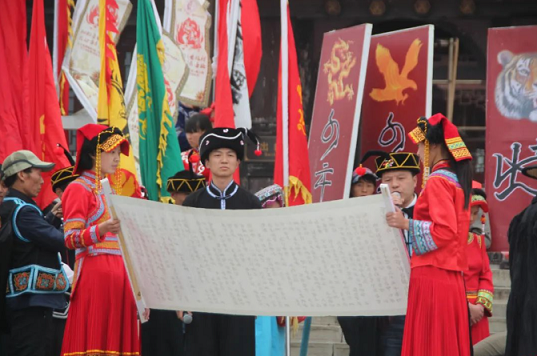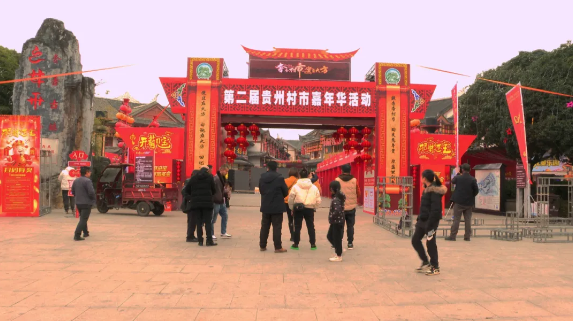- Profile Jurisdictions GOV DEPARTMENTS Cultures Travelling Educate
-
During the Xia Dynasty, the area within Dafang County was part of the southern wilderness of Liangzhou. During the Shang Dynasty, it belonged to the western border of Jingzhou. During the Zhou Dynasty, it was part of the Lu Yi Kingdom. During the Warring States period, it was under the jurisdiction of the Yelang Kingdom. After the Qin Dynasty conquered Yelang, it established the counties of Yelang and Hanyang, with the county territory belonging to Hanyang County. During the Western Han Dynasty, it belonged to the Zangke Commandery, and during the Eastern Han Dynasty, it was under the jurisdiction of the Lulu tribe.

In the third year of the Jianxing era of the Shu Han dynasty (225), Zhuge Liang launched a southern campaign. Tuo A Zhe (Ji Huo), the 25th descendant of the Mo tribe of Kunming Yi, contributed grain and opened a passageway, assisting in the capture of Meng Huo and thus earning merit. He was封 as the King of Luodian and ordered to rule the region. Tuo Aze moved from Longgeng (present-day Qixingguan, Bijie) to Baizhago (present-day Dafang County) and built the Mu'ege Castle at the foot of Zhuzha Mountain (present-day Yunlong Mountain). The county was under the jurisdiction of the Luodian Kingdom.
During the Tang and Song dynasties, it was the seat of Yao Prefecture. During the Song dynasty, it belonged to Pingman Commandery. During the Song and Yuan dynasties, it was under the jurisdiction of the Luo family's Ghost Kingdom. During the Yuan and Ming dynasties, it successively belonged to the Yixi Buxue (Shuixi) Xuanwei Prefecture, Guizhou Xuanwei Prefecture, and Shuixi Xuanwei Prefecture.
During the mid-to-late Ming Dynasty, it administered 12 Zexi. In the eighth year of Chongzhen of the Ming Dynasty (1635), Guizhou Governor-General Zhu Xieyuan dispatched Deputy General Fang Guoan to build a city, and the county seat was first named Dafang.
In the third year of the Kangxi reign of the Qing Dynasty (1664), the Xuanwei Commissioner An Kun rebelled against the Qing Dynasty. The following year, he was subdued by Wu Sangui, who petitioned to replace the local officials with imperial appointees and establish a prefectural seat. In the fifth year of the Kangxi reign (1666), the city of Dafang was renamed Dading, and the Dading Prefecture was established with the territories of the four Zexi: Mukuo, Huozhuo, Huagge, and Jiale. In the 26th year of the Kangxi reign (1687), Dading Prefecture was renamed Dading State and placed under the jurisdiction of Weining Prefecture. In the 37th year of the Kangxi reign (1698), the rule of local officials was abolished. In the 8th year of the Yongzheng reign (1730), Dading Prefecture was restored, and Weining was downgraded to a state, along with Pingyuan State, Qianxi State, and Bijie County, all under the jurisdiction of Dading Prefecture.

In the 3rd year of the Republic of China (1914), the prefectural administration was abolished, and Dading County was established, subordinate to the Qianxi Circuit of Guizhou Province. In the 24th year of the Republic of China (1935), it was transferred to the Fourth Inspectorate Special Commissioner's Office of Guizhou Province.
On 25 November 1949, the county seat of Dading was liberated. On 5 December, the Dading County People's Government was established, subordinate to the Bijie Special Commissioner's Office, and the old regime's 4 towns and 16 townships were reorganised into 5 administrative districts.
In January 1950, it was reorganised into 5 districts, administering 4 towns and 16 townships. In July, the townships and towns were abolished and reorganised into 13 administrative districts: Chengguan, Xiangshui, Shuangshan, Poji, Machang, Lihua, Jichang, Liulong, Bainai, Daxi, Piaojing, Changshi, and Shachang, with district people's governments established. From September 1949 to May 1950, the biao system was abolished, and 256 biao were reorganised into 228 villages (including 8 streets in Chengguan), with village (street) people's governments established.
In April 1953, the consolidation of villages into townships was completed, with 228 villages (streets) reorganised into 138 townships and 4 streets, and township people's governments were established. At the same time, the district people's governments were renamed district offices, serving as派出 institutions of the county people's government.
In February 1958, with the approval of the State Council, Dading County was renamed Dafang County.
In October 1961, the district system was restored, with the county divided into 13 districts and 62 people's communes.
In March 1963, the 13 districts and 62 people's communes were reorganised into 109 people's communes and 1 town.
In April 1978, the 13 districts were restored.
In 1984, township (town) governments were established. The county was divided into 13 districts and 1 district-level town; 14 township-level towns, 95 townships (including 33 ethnic townships); 4 sub-district offices, 10 residents' committees, and 506 villagers' committees; 83 residents' groups and 4,053 villagers' groups.
In May 1991, the Jixing Yi and Miao Ethnic Township of Baina District was transferred to Qianxi County. In December of the same year, following approval by the People's Government of Guizhou Province, the 109 townships (at the section level) under the jurisdiction of the 14 districts (including 1 district-level town) were merged to form 10 towns and 26 townships (including 18 ethnic townships). The 36 towns (at the section level) administered 499 administrative villages, 31 residents' committees, 3,932 village groups, and 131 residents' groups.
In 2003, the county government approved the merger of some administrative villages, reducing the original 499 administrative villages and 31 residents' committees to 367 villages and 22 community residents' committees.
In December 2007, the Bijie Region established the Bili Dujuan Management Zone. Dafang County entrusted the management of the Pudi Yi, Miao, and Bai Ethnic Township and the Dashi Yi, Miao, and Bouyei Ethnic Township to the Bili Dujuan Management Zone. In 2008, the Huangnitang Town's five villages of Gong, Qingmen, and Longping, Longfeng, and Longzhu from the Baina Township were entrusted to the Bili Dujuan Management Zone for administration. In May 2012, the two villages of Jiamu and Dayan from the Huangni Township were entrusted to the Bili Dujuan Jiamu Management Zone for administration.
On 1 August 2012, the Municipal Party Committee and Municipal Government decided to establish the Bijie City Shuangshan New District Administrative Committee, entrusting the management of Xiangshui Township and Shuangshan Town of Dafang County, as well as the four villages of Wafang, Changfeng, Sanyuan, and Taihe in Wenge Township, to the Shuangshan New District Administrative Committee.
In November 2013, Jichang Township and Huangnitang Town were abolished, and a new Huangnitang Town was established, with the administrative area of the new Huangnitang Town comprising the former areas of Jichang Township and Huangnitang Town. The town government is located in Huangni Village. Gaodian Township was abolished, and Duijiang Town was established, with the administrative area of the new Duijiang Town comprising the former areas of Gaodian Township and the villages of Jinxing, Wanzi, Duijiang, Qingmu, Fashu, Longjing, Yuanshao, Shanshin, and Huaguo villages of Dafang Town as the administrative area of Duijiang Town, with the town government located in Yantang Village. Dafang Town was abolished, and Mu'erge Ancient City, Shunde, and Hongqi were established as three sub-districts.
In August 2014, the Dafang County People's Government entrusted the management of the four villages of Wenge, Anqing, Haiba, and Zhongzhai from Zhuyuan Township and Wenge Township to the Shuangshan New District Administrative Committee. In September 2014, Wenge Township was also entrusted to the Shuangshan New District Administrative Committee for management.
On 6 December 2015, the Jinhaihu New District of Bijie City was officially established, formed by the integration of the original Bijie Shuangshan New District and the Guizhou Bijie Economic Development Zone. It is a county-level institution dispatched by the Bijie Municipal Committee of the Communist Party of China and the Municipal People's Government. The four townships of Shuangshan, Xiangshui, Zhuyuan, and Wenge in Dafang County were all entrusted to the Jinhaihu New District for management. In February 2017, Dafang County entrusted the administration of Baina Township, Huangni Township, Shachang Township (excluding the two villages of Cangshang and Malong), and the two villages of Baiji and Lianxing in Fengshan Township to the Bili Dujuan Management Zone.

On 2 August 2019, in the ‘Provincial People's Government's Approval on the Adjustment of Partial Administrative Divisions in Bijie City,’ it was agreed to establish Jiuyi Subdistrict, Guihua Subdistrict, and Pengcheng Subdistrict in Dafang County. Jiuyi Subdistrict administers the following communities from the former Shunde Subdistrict: Jiayuan Community, Tongxin Community, Xingfu Community, Baishi Community, Yansha Community, and Yushishi Community, as well as Dazhai Community from the former Dongguan Township. The subdistrict office is located in Xingfu Community; Guihua Subdistrict administers Xiangtian Community, Yangliu Community, and Guihua Community from the former Shuangshan Town, as well as Changfeng Community and Wafang Community from the former Wenge Township. The subdistrict office is located in Guihua Community; Pengcheng Subdistrict administers Pengcheng Community, Qiaotou Community, Dashui Community, Shiniu Community, Pingzi Community, Qihua Village, and the former Huangnitang Town's Zhaogong Community, Qingmen Village, and Zhaogong Village, as well as the former Fengshan Yi and Mongolian Ethnic Group Township's Lianxing Village and Baiji Village. The sub-district office is located in Pengcheng Community. Following the administrative division adjustment, Shunde Subdistrict administers Xinzhuang Community, Xiaolu Community, Datun Community, Longchang Community, Xipu Community, Jinyu Community, and Shiquang Community, with the Subdistrict Office located in Xinzhuang Community; Dongguan Township administers Geya Community, Jinping Community, Tianping Community, Chaozhong Community, Qijiatian Community, Luozhai Community, Tongxin Community, Longquan Village, Banchong Village, and Hezhong Village, with the town government located in Luozhai Community; Shuangshan Town now administers Shuangshan Community, Yaotang Community, Zhonglu Community, Shazi Community, Xiaoba Community, Songshu Community, Pingyuan Community, Gaoping Community, Mugge Community, Fashu Village, Pulu Village, and Hongxing Village, with the town government located in Shuangshan Community; Wenge Township now administers Anqing Community, Wenge Community, Sanyuan Community, Zhongzhai Village, Haiba Village, and Taihe Village. The town government is located in Wenge Community. Pudi Yi, Miao, and Bai Ethnic Group Township administers Paoma Community, Dongfeng Community, Yongfeng Community, Dahuang Community, Shagou Village, Qingfeng Village, Yingfeng Village, Lianfeng Village, Hongfeng Village, and Yongxing Village. The town government is located in Paoma Community. Huangnitang Town administers Huangnitang Community, Hualian Community, Gantang Community, Xintang Community, Xihe Community, Jichang Community, Songlin Community, Beizuozhai Village, Kuishu Village, Yingxin Village, Daba Village, Tianshang Village, Huali Village, Xinglin Village, Luozhuang Village, Meijing Village, and Anping Village. The town government is located in Huangnitang Community. Fengshan Yi and Mongolian Ethnic Township administers Fengshan Community, Dianzhu Community, Qifeng Community, Xiedu Village, Yangyan Village, Shiping Village, Yinchuan Village, and Shangping Village. The township government is located in Fengshan Community. On 8 November 2019, Jiuyi Subdistrict was officially established.
On 21 March 2022, the Jinhaihu New District was abolished, and the administrative licensing matters of the four townships of Shuangshan, Xiangshui, Zhuyuan, and Wenge in Dafang County, as well as part of the administrative licensing matters of the Guihua Subdistrict, were delegated to the Qixingguan District for handling.
By the end of 2023, excluding the managed towns (townships and sub-districts), the county will administer four sub-districts: Hongqi Sub-district, Shunde Sub-district, Mou'ege Ancient City Sub-district, and Jiuyi Sub-district; and nine towns: Maochang Town, Machang Town, Yangchang Town, Huangnitang Town, Duijiang Town, Liulong Town, Daxi Town, Piaojing Town, and Changshi Town; as well as Dongguan Township, Lvtang Township, Dingxin Yi and Miao Ethnic Township, Niuchang Miao and Yi Ethnic Township, Xiaotun Township, Lihua Miao and Yi Ethnic Township, Fengshan Yi and Mongolian Ethnic Township, Anle Yi and Gelao Ethnic Township, Hezuo Yi and Bai Ethnic Township, Baobao Yi and Miao Ethnic Township, Xinglong Miao Ethnic Township,
contact details
Tel:00-86-0857-5221392
Address:No. 18, Shaxiang Avenue, Dafang County, Bijie City (formerly the Public Security Bureau Building),
Working hours:Morning: 08:30–12:00 Afternoon: 14:00–17:30
